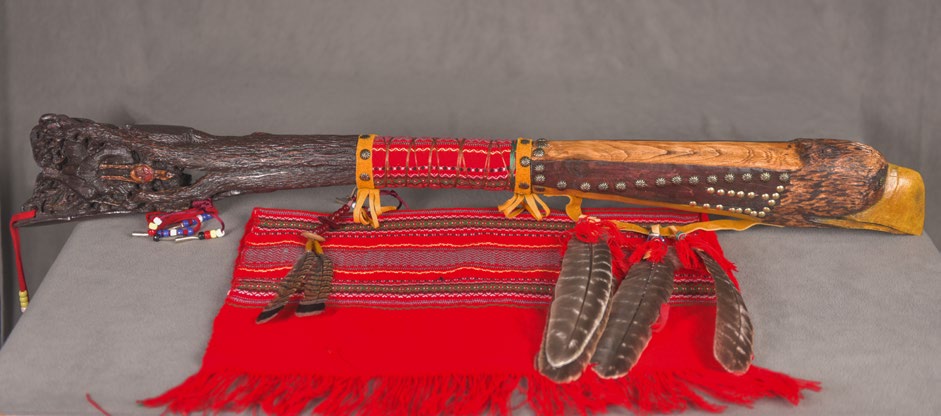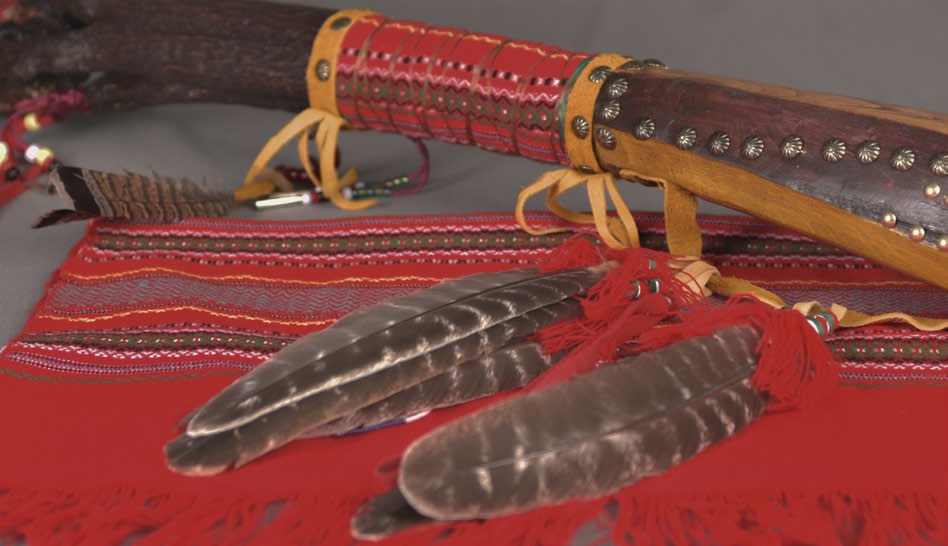Meet “Nsidwaamjigan,”ceremonial object created to open NOSM University convocations

On May 26, 2023, hundreds of people stood respectfully in silence, listening to the powerful sounds of Indigenous singing and drumming, waiting for the graduates to appear. Then, as the formal convocation procession began, a carved eagle’s head club emerged, leading the way.
The carefully-hewn head is the end of Nsidwaamjigan, the beautiful new ceremonial object that will now open all of NOSM University’s convocation ceremonies. Created by Algonquin artist Bradly (Dreamwalker) MacDonald, a Waskabe (Helper) based in North Bay, Nsidwaamjigan means “it recognizes achievements” in Anishnawbemowin, and the baton-like object was named by a group of Elders and Knowledge Keepers.
While Nsidwaamjigan holds some similarities to a ceremonial mace or staff, it is also distinct. For that reason, the Elders and Knowledge Keepers resolved that it should be referred to by its name alone: Nsidwaamjigan.
For the artist, taking on the creation this piece was an important way to honour healers.
“Everybody that comes to NOSM University is a healer,” says MacDonald. “The most selfless path is to be a healer. It’s a hard commitment to go on the journey. For many healers, they forsake all the different things they have in their lives and they focus on other people’s lives. The healers are extremely important.”
“Healers will see thousands upon thousands of faces,” he continues. “It takes a great deal of commitment. You give honour to the people being served as well as their future generations by the thousands.”
As MacDonald speaks about Nsidwaamjigan, it’s clear that the object is rooted in a philosophy of interconnectedness.
“Instead of saying that certain things have a soul and others don’t, we recognize that everything has a soul,” he says. “We have everything within us that connects us to everything. It’s a matter of how much we can find that and love that. Everything in life is sacred. The root of everything in life is the sacredness of how we treat things.”
Nsidwaamjigan is in the form of a tree, representing the tree of life. It features petroglyphs, which symbolize the sacredness of family connection.
Petroglyphs “have been here since the beginning,” and harken back to “the oldest petroglyph, the Milky Way,” says Bradly. It includes four branches—black, red, yellow, and white—which represent the guardians of different directions of the Universe and of the Earth, and a balance rooted in all things. The eagle on the top of Nsidwaamjigan represents the sun, an awakening, the enlightenment of a person’s self, and the realization of what it means to be a healer.
The history of ceremonial maces is rooted in colonialism. The first maces date back to the Stone Age, and early maces were clubs used to physically protect the king’s person. In contemporary use, maces are present at many legislative assemblies—in fact, some governments cannot legally convene without the presence of the mace—and they represent authority. Canada is one of many commonwealth countries where a mace is used in the House of Commons to represent the authority of King Charles II.
Maces also have a longstanding use in convocation ceremonies. In Britain, the oldest extant maces date from the 15th century and belong to the University of Saint Andrews and the University of Glasgow. At a time when only the white male elite attended university, convocation ceremonies were gatherings of the upper-class, and maces had the practical purpose of guarding against attacks, as well as a ceremonial use.

In today’s academic settings, a mace is said to represent the independent authority of the university. In a North American context, they are primarily used at convocation ceremonies.
Bradly acknowledges the object’s colonial history and notes how the meaning is different for him, “This is a recognition of people’s honour. It is their honour that helps guide them and what they’re doing,” he says. “It’s an empowering tool rather than a controlling one. This is not a war club. It’s letting people know that they are to be honoured. We honour you, because you are a healer.”
Dr. Joseph LeBlanc, Associate Dean, Equity and Inclusion, liaised with the Elders and Knowledge Keepers about the use of the piece. “We wanted this piece to depart from the colonial role that maces have played at universities,” he says. “Nsidwaamjigan represents the spirit and intent of this institution. When we talk about anti-racism and anti-oppression, we need to arm our graduates with tools for those battles.”
Approximately 20 Elders and Knowledge Keepers received Nsidwaamjigan to its home at NOSM University during a pipe ceremony. After smudging, the Elders and Knowledge Keepers sat with Nsidwaamjigan and discussed what it means to them.
Although Nsidwaamjigan includes a carving of an eagle head, the Elders and Knowledge Keepers note that it is not an eagle staff, which is a distinct ceremonial object with an important role in some Indigenous ceremonies. The feathers on Nsidwaamjigan are from turkeys and grouse, both important and healthy food species.
Dr. Sarita Verma, President, Vice-Chancellor, Dean, and CEO of NOSM University, is very enthusiastic about the piece. “Being a new university, we had a terrific opportunity to do something different, and we took it,” she says. “What’s more, I’m thrilled with the result. I think Nsidwaamjigan is a beautiful contemplation on what NOSM University is all about.”
The figure of a being
At the center of the roots sits our story from the beginning of everything and that is where we see our future. Completely in balance and ready to fulfill the promises we give in the beginning.
On the opposite side are the fundamental petroglyphs of family and our guiding spirit.
Our inner power that constantly brings us gifts to face the world and journey forth as family in harmonious celebration.
The tree is the tree of life and the center of our understanding that all forms of life and visions of sacredness are equal and important, because we are all family.
From here we are open to our spiritual journey and understanding of Traditional Knowledge.
Artist statement
The base has four directional roots. Each one is equal parts in importance and necessary in balance and growth.
Spiritual: Commitment remembering the sacredness of all life and honouring the beauty in all things around us.
- The first breath of life, the promise never to forsake the beauty of this great mystery and always strive upward to make the future generations dance in harmony (like the leaves in the morning sun).
Mental: Commitment to dispel misconceptions and bring forth harmony by striving to the highest standards of integrity.
- This agreement with ourselves is to honour each aspect of our growth with love and compassion.
Physical: Commitment to keep our bodies and hearts clear and in harmony with natural balance. We are also born into this sacred life as humane healers that assist in bringing forth balance to many that suffer.
- Commitment to ease the suffering of others is the highest calling of humanity because it brings honour to your future generations.
Emotional: Commitment to experiencing the beauty of life and bringing back the original experience of wonder from before any trauma, be it very small or large.
- Knowledge and great depth of feeling is essential in traditional understanding.
